Related Research Articles

Sir Hubert Ferdinand Opperman, OBE, referred to as Oppy by Australian and French crowds, was an Australian cyclist and politician, whose endurance cycling feats in the 1920s and 1930s earned him international acclaim.
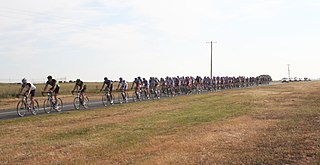
The Melbourne to Warrnambool Classic cycling race is a one-day road bicycle race. The race started in 1895 and is Australia's oldest one day race and the world's second oldest one day race, after the Liège–Bastogne–Liège Classic. Historically until 1938 the race started in Warrnambool and finished 165 miles (266 km) later in Melbourne. In 1895 the race was run in the opposite direction, from Melbourne to Warrnambool and then again from 1939. The route started in the Melbourne central business district and followed the Princes Highway to Warrnambool on Victoria's western coast. This traditional route was the longest race on the Union Cycliste Internationale (UCI) calendar, the exact distance varying slightly over time.
Henry George Watson was the first New Zealander to ride in the Tour de France. In 1928, he teamed up with Australian cyclists, Hubert Opperman, Percy Osborn and Ernie Bainbridge. They were the first English-speaking team to ride the Tour de France.

The Australian National Road Race Championships, are held annually with an event for each category of bicycle rider: Men, Women & under 23 riders. The event also includes the Australian National Time Trial Championships since 2002. The Australian Championships were officially known as the Scody Australian Open Road Cycling Championships from 1999 to 2010, taking the name of their main sponsor. This changed to the Mars Cycling Australia Road National Championships from 2011 but they are more commonly referred to as The Nationals. The under 23 championships were introduced in 2001. Note that these results do not currently include the senior and junior amateur road race championships that were held prior to the open era.

Malvern Star is a manufacturer of bicycles based in Melbourne, Australia. The company was established in 1902, and went on to become a known brand in Australia.

Richard William "Fatty" Lamb was an Australian racing cyclist who competed on both road and track, as was typical of Australian cyclists of the era such as Hubert Opperman. Throughout his career, Lamb was associated with Malvern Star Bicycles and Bruce Small.

Oserick Bernard "Ossie" Nicholson was an Australian cyclist who twice held the World Endurance record for distance in a calendar year.
Frankie Thomas was an Australian racing cyclist who competed on both road and track, as was typical of Australian cyclists of the era such as Hubert Opperman.
Maurice "Jack" Fitzgerald was an Australian Track racing cyclist, particularly in sprint and Six-day racing.
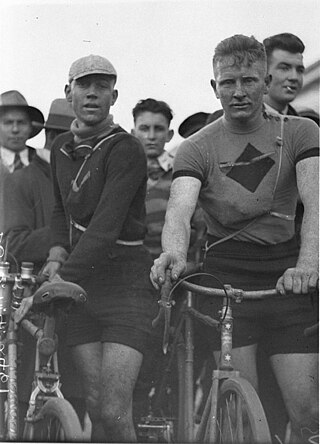
Ernest Milliken was an Australian Road racing cyclist who performed strongly in distance races and individual time trials.

The Goulburn to Sydney cycling race was a one-day road bicycle race. The first race was held in 1902 with the last in 2012.
Walter "Hefty" Stuart (1912–1938) was an Australian cyclist who competed on both road and track, as was typical of Australian cyclists of the era such as Hubert Opperman and Richard Lamb.
Ernest "Ernie" Bainbridge (1890–1984), also known as Ern Bainbridge, was an Australian racing cyclist, who is best known for competing in the 1928 Tour de France with fellow Australian Percy Osborn and Hubert Opperman and New Zealander Harry Watson.
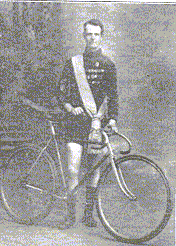
Duncan "Don" Kirkham was an Australian racing cyclist. Kirkham was a regular competitor in Australian long distance cycling races. He won the Goulburn to Sydney Classic in 1910, riding off scratch and setting the fastest time. In 1911 he was 2nd and set the fastest time, riding the 131 miles (211 km) in a record time of 6h 19' 31". Kirkham's time was not beaten until 1925 by Richard "Fatty" Lamb. He had previously finished 5th in 1909. and finished outside the top 20 in 1912.
Alan "Pete" Angus (1912–1988) was an Australian racing cyclist.
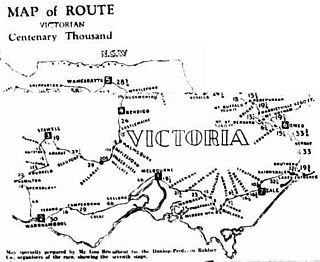
The Centenary 1000 cycling race was a one-week road bicycle race over seven stages covering 1,102 miles (1,773 km). The race was run in 1934 as part of the celebrations of the Centenary of Victoria. The race was originally conceived along the lines of the Dunlop Grand Prix, won by Hubert Opperman then aged 23, by 1h 20' and the concept for the race was covering 1,000 miles (1,600 km) with prizes exceeding £1,000, including a climb over Mount Hotham.
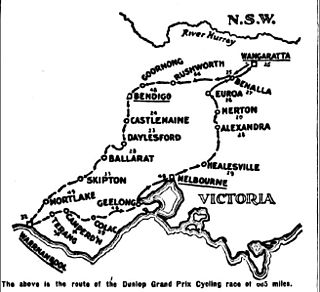
The Dunlop Grand Prix was, in 1927, the biggest cycling race in the British Empire and the richest race in the world. It was organised by the Dunlop Rubber Company which had a long history of organising bicycle races, including the Warrnambool to Melbourne, Colac to Melbourne and Goulburn to Sydney. As a result of the Dunlop Grand Prix, the Warrnambool was not held in 1927 however the Colac and Goulburn races were.
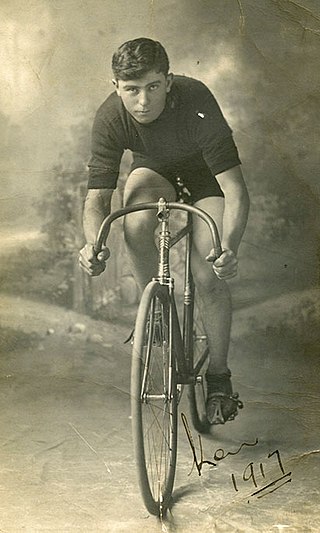
Ken Gordon Ferndale Ross (1900–1974) was an Australian road and track cyclist. His best results were achieved in the Goulburn to Sydney, where he set the fastest time on three occasions and in the Sydney Six-day race which he won three times.

Le Ride is a film which recreates the 1928 Tour de France ride by the four-person Australasian team, and in particular of the New Zealander in their midst, Harry Watson. The Amazing Race host Phil Keoghan and his riding partner Ben Cornell completed the 5,600-kilometre (3,500 mi) ride in 22 stages spread over 26 days to the original schedule in 2013. Keoghan's wife Louise Keoghan was the producer for the film, which premiered in Watson's home town Christchurch in July 2016.
Ravat–Wonder–Dunlop was a cycling team formed for the 1928 Tour de France.
References
- ↑ ProCyclingStats
- ↑ "Aussie Highlights at Goulburn - Sydney Cycle Classic". Australian Cycling Memories website. Archived from the original on 25 July 2015. Retrieved 24 July 2015.
- ↑ "Opperman scores". New Zealand Truth. 24 November 1927. Retrieved 24 July 2015.
- ↑ "Cup Trophy - Cycling, Awarded to Hubert Opperman, C.B. Kellow, Dunlop Road Race (Dunlop Grand Prix), Victoria, 1927". Museum Victoria website. Archived from the original on 24 July 2015. Retrieved 24 July 2015.
- ↑ "Dunlop Grand Prix". The Australasian . Melbourne, Vic.: National Library of Australia. 26 November 1927. p. 72.
- ↑ Slade, Andrew. "Koo-Wee-Rups cycling heritage" (PDF). Koo Wee Rup Blackfish, August 2014. Retrieved 24 July 2015.